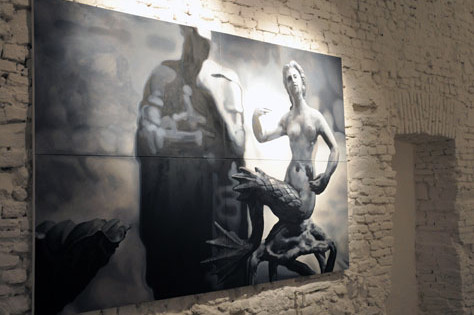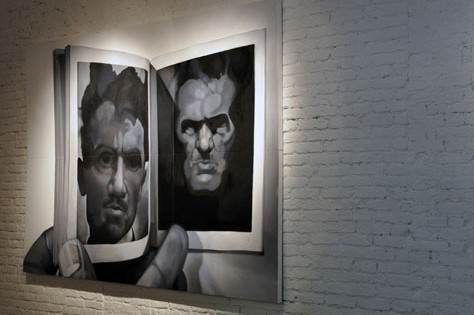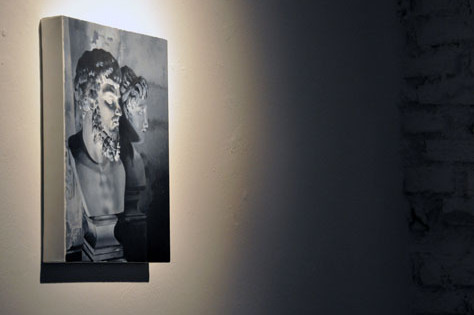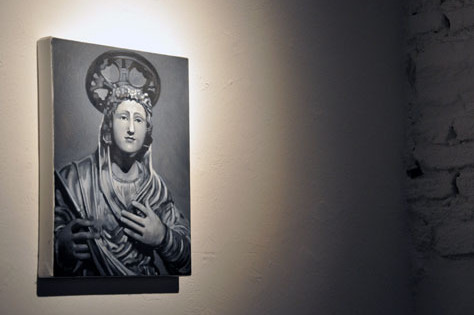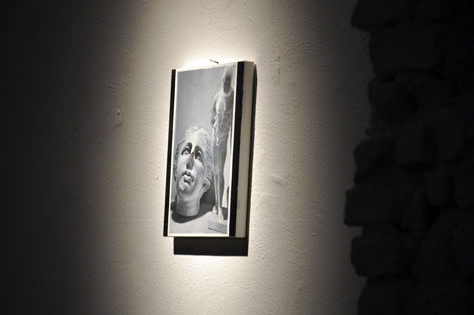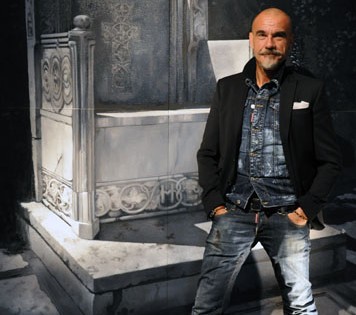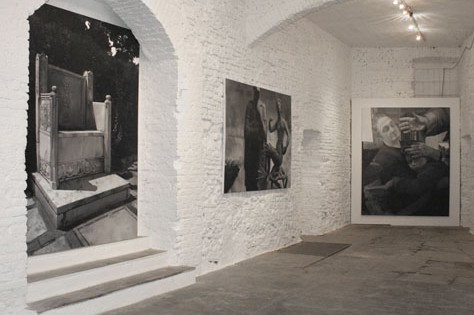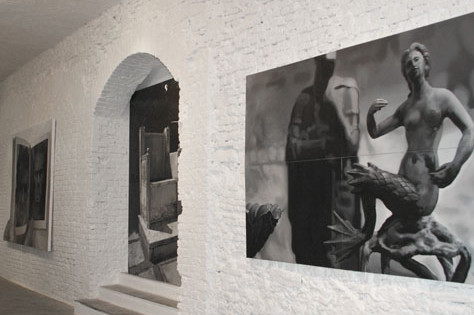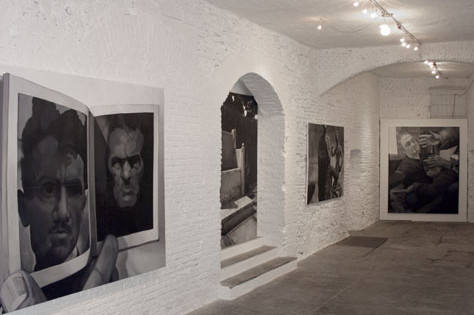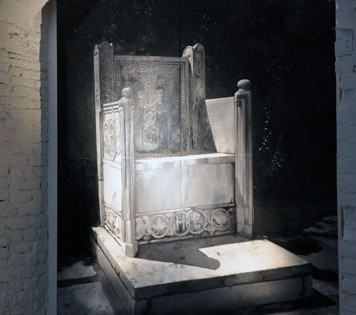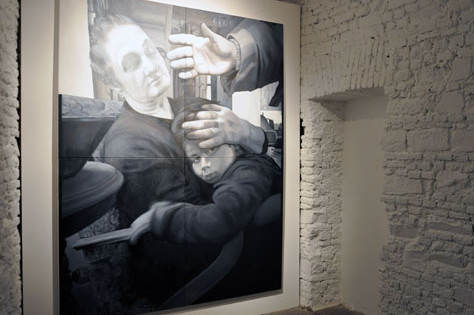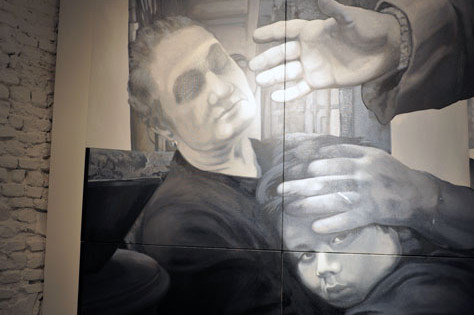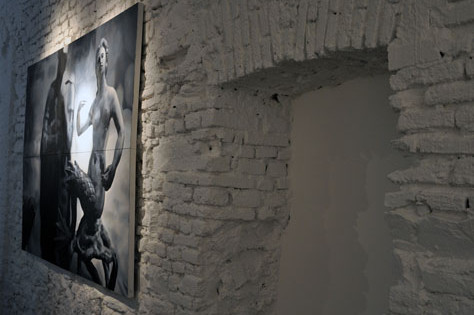BODINO Cabinet Privé
There are no colours in Giampiero Bodino’s most recent paintings. What emerges from these works, whether large or small (he doesn’t like middle sizes), is an essential and rigorous universe, free from any attempt at facile allure.
What interests him are volume and line. And like art historians of the old school, who in order to investigate thoroughly a painting of the past, even one glowing with colour, preferred to look at a black-and-white photograph, he makes use of a reduced and austere palette, made up – at least at first glance – solely of blacks and whites.
The fact that instead of intermediate shades of grey these compose a rich range of tones only becomes apparent on closer examination of the pictures, and at an angle: that is when it becomes possible to perceive the vibrancy of his greys (and his whites, and his blacks) and the different degrees of brilliance bestowed on their ‘skin’, one moment velvety, able to absorb the light, the next silky, capable of reflecting it softly. This is what happens with the leaves, black on black, of the hedge that forms the backdrop to the Byzantine throne of Ca’ Venier dei Leoni, in Venice, the subject of one of his large paintings.
Peggy Guggenheim liked to receive guests seated on that chair, as the true ‘last dogaressa’ that she knew herself to be. And it was there that her ashes were interred, next to the small tombs of her beloved Lhasa Apso dogs. Bodino has painted it with a slight sotto in sù perspective, accentuating its monumentality, and made it the protagonist of one of his most accomplished pictures.
Grazed by a limpid light, with its pure white against the background of the black hedge, that empty seat becomes a reflection on absence, ‘an act of removal’ he explains. And even if we didn’t know that the ashes of its last owner are there nearby, the layout of the image and the almost metaphysical light in which it is steeped would make the painting look like a reflection on the passing of time, like an antique vanitas translated into the language of our day. And this is precisely what seems to be the most authentic and personal characteristic of Bodino’s paintings, that they feed on the past but live fully in the contemporary world.
To create his luminous epiphanies, the artist makes use of photographs that he takes himself. Then he intervenes with a sophisticated process of post-production, through which he takes away the colour and, instead, emphasizes the chromatic qualities of the blacks and whites.
Thus it is no surprise that in his other role, that of collector, the medium he prefers above any other is sculpture. And in particular, the sculpture of as raw, visionary (and great) an artist as Adolfo Wildt, to whom he has devoted another large painting.
Here a hand – his own – holds a small book, open onto a double portrait of the tormented sculptor: the Omaggio a Wildt published by Giovanni Scheiwiller in 1932, on the first anniversary of his death. And in painting it Bodino seems to want to also pay homage to the solid and substantial painting of this magnificent artist, primarily a sculptor but also an excellent painter and draftsman, the author of works (like Bodino’s) that were always monochrome, in grisaille.
But the sculpture that he collects obsessively is also the protagonist of some small, or even tiny works: ‘they are little subjects of which I am fond,’ says Bodino, who in fact has given this solo exhibition the title of Cabinet privé, ‘with which I like to compose still lifes, that for me are true “reliquaries of the spirit”.’ In fact he underlines the emotional charge of each of them through a highly effective process in which, in the same painting, he seems to place black-and-white photographic prints alongside negatives, thereby turning some of these sculptures into purely spectral presences.
_______________________________________________________________
Non ci sono colori negli ultimi dipinti di Giampiero Bodino. Quello che emerge da questi suoi lavori, grandiosi o minuscoli che siano (lui non ama i medi formati), è un universo essenziale e rigoroso, libero da ogni tentativo di facile seduzione.
Ciò che gli interessa sono il volume e la linea. E come gli storici dell'arte di vecchia scuola, che per investigare a fondo la pittura antica, anche la più sfolgorante di colori, preferivano le fotografie in bianco e nero, così lui si serve di una tavolozza ridotta e severa, fatta –almeno a un primo sguardo– di soli bianchi e di neri.
Che poi invece le sfumature intermedie dei grigi compongano una gamma ricchissima di tonalità, questo lo si coglie solo con uno sguardo più ravvicinato, e radente: è allora infatti che si può percepire la ricchezza dei suoi grigi (e dei suoi bianchi, e dei suoi neri) e il grado diverso di lucentezza conferito alla loro “pelle”, ora vellutata, capace di assorbire la luce, ora setosa, in grado di rifletterla sommessamente. Accade con le foglie, nero su nero, della siepe che fa da sfondo al trono bizantino di Ca' Venier dei Leoni, a Venezia, oggetto di un suo grande dipinto.
Seduta su quel seggio Peggy Guggenheim amava ricevere gli ospiti da vera “ultima dogaressa”, quale sapeva di essere. E lì volle che fossero interrate le sue ceneri, accanto alle piccole tombe degli amati cagnolini tibetani. Bodino lo ha dipinto con un leggero sottinsù, accentuandone la monumentalità, e ne ha fatto il protagonista di uno dei suoi dipinti più compiuti.
Colpito da una luce limpida e obliqua, con il suo bianco puro sullo sfondo della siepe nera, quel seggio vuoto diventa una riflessione sull'assenza, «un atto di sottrazione» spiega. E se anche non si sapesse che lì di fianco ci sono le ceneri dell'ultima proprietaria, per l'impaginazione dell'immagine e per la luce quasi metafisica che lo bagna, il dipinto si proporrebbe come una riflessione sul tempo che fugge, come un'antica vanitas tradotta nella lingua del nostro tempo. E proprio questa ci sembra essere la cifra più vera e personale dei dipinti di Bodino, che si nutrono di passato ma vivono più che mai nella contemporaneità.
Per realizzare le sue epifanie luminose, l'artista si serve di fotografie che scatta lui stesso. Poi interviene con un sofisticato processo di post-produzione, con il quale sottrae il colore e, all'opposto, enfatizza le cariche cromatiche dei neri e dei bianchi.
Non stupisce perciò che nell'altra sua veste, quella di collezionista, prediliga più d'ogni altro medium la scultura. E in particolare la scultura di un artista crudo, visionario (e grandissimo) quale è Adolfo Wildt, a cui dedica un altro grande dipinto.
Qui una mano –la sua– impugna, aperto su un doppio ritratto dell'ombroso, tormentato scultore, un piccolo libro: l'Omaggio a Wildt edito da Giovanni Scheiwiller nel 1932, nel primo anniversario della morte. E nel dipingerlo Bodino sembra voler rendere omaggio anche alla pittura, solida e volumetrica, di questo artista grandioso, scultore innanzitutto ma anche eccellente pittore e disegnatore, autore di opere (come le sue) sempre monocrome, a grisaille.
Ma la scultura, quella che colleziona ossessivamente , torna da protagonista anche in alcune piccole, o addirittura minuscole, opere: «sono piccoli soggetti di affezione -dice Bodino, che infatti ha intitolato Cabinet privé questa personale-, con cui amo comporre degli still life, nature morte che sono per me veri “reliquiari dello spirito”». Di ognuno infatti evidenzia la carica emozionale grazie a un processo di grande efficacia, in cui, nello stesso dipinto, sembra mettere a confronto stampe fotografiche in bianco e nero e negativi, trasformando così alcune di queste sculture in pure presenze fantasmatiche.
What interests him are volume and line. And like art historians of the old school, who in order to investigate thoroughly a painting of the past, even one glowing with colour, preferred to look at a black-and-white photograph, he makes use of a reduced and austere palette, made up – at least at first glance – solely of blacks and whites.
The fact that instead of intermediate shades of grey these compose a rich range of tones only becomes apparent on closer examination of the pictures, and at an angle: that is when it becomes possible to perceive the vibrancy of his greys (and his whites, and his blacks) and the different degrees of brilliance bestowed on their ‘skin’, one moment velvety, able to absorb the light, the next silky, capable of reflecting it softly. This is what happens with the leaves, black on black, of the hedge that forms the backdrop to the Byzantine throne of Ca’ Venier dei Leoni, in Venice, the subject of one of his large paintings.
Peggy Guggenheim liked to receive guests seated on that chair, as the true ‘last dogaressa’ that she knew herself to be. And it was there that her ashes were interred, next to the small tombs of her beloved Lhasa Apso dogs. Bodino has painted it with a slight sotto in sù perspective, accentuating its monumentality, and made it the protagonist of one of his most accomplished pictures.
Grazed by a limpid light, with its pure white against the background of the black hedge, that empty seat becomes a reflection on absence, ‘an act of removal’ he explains. And even if we didn’t know that the ashes of its last owner are there nearby, the layout of the image and the almost metaphysical light in which it is steeped would make the painting look like a reflection on the passing of time, like an antique vanitas translated into the language of our day. And this is precisely what seems to be the most authentic and personal characteristic of Bodino’s paintings, that they feed on the past but live fully in the contemporary world.
To create his luminous epiphanies, the artist makes use of photographs that he takes himself. Then he intervenes with a sophisticated process of post-production, through which he takes away the colour and, instead, emphasizes the chromatic qualities of the blacks and whites.
Thus it is no surprise that in his other role, that of collector, the medium he prefers above any other is sculpture. And in particular, the sculpture of as raw, visionary (and great) an artist as Adolfo Wildt, to whom he has devoted another large painting.
Here a hand – his own – holds a small book, open onto a double portrait of the tormented sculptor: the Omaggio a Wildt published by Giovanni Scheiwiller in 1932, on the first anniversary of his death. And in painting it Bodino seems to want to also pay homage to the solid and substantial painting of this magnificent artist, primarily a sculptor but also an excellent painter and draftsman, the author of works (like Bodino’s) that were always monochrome, in grisaille.
But the sculpture that he collects obsessively is also the protagonist of some small, or even tiny works: ‘they are little subjects of which I am fond,’ says Bodino, who in fact has given this solo exhibition the title of Cabinet privé, ‘with which I like to compose still lifes, that for me are true “reliquaries of the spirit”.’ In fact he underlines the emotional charge of each of them through a highly effective process in which, in the same painting, he seems to place black-and-white photographic prints alongside negatives, thereby turning some of these sculptures into purely spectral presences.
_______________________________________________________________
Non ci sono colori negli ultimi dipinti di Giampiero Bodino. Quello che emerge da questi suoi lavori, grandiosi o minuscoli che siano (lui non ama i medi formati), è un universo essenziale e rigoroso, libero da ogni tentativo di facile seduzione.
Ciò che gli interessa sono il volume e la linea. E come gli storici dell'arte di vecchia scuola, che per investigare a fondo la pittura antica, anche la più sfolgorante di colori, preferivano le fotografie in bianco e nero, così lui si serve di una tavolozza ridotta e severa, fatta –almeno a un primo sguardo– di soli bianchi e di neri.
Che poi invece le sfumature intermedie dei grigi compongano una gamma ricchissima di tonalità, questo lo si coglie solo con uno sguardo più ravvicinato, e radente: è allora infatti che si può percepire la ricchezza dei suoi grigi (e dei suoi bianchi, e dei suoi neri) e il grado diverso di lucentezza conferito alla loro “pelle”, ora vellutata, capace di assorbire la luce, ora setosa, in grado di rifletterla sommessamente. Accade con le foglie, nero su nero, della siepe che fa da sfondo al trono bizantino di Ca' Venier dei Leoni, a Venezia, oggetto di un suo grande dipinto.
Seduta su quel seggio Peggy Guggenheim amava ricevere gli ospiti da vera “ultima dogaressa”, quale sapeva di essere. E lì volle che fossero interrate le sue ceneri, accanto alle piccole tombe degli amati cagnolini tibetani. Bodino lo ha dipinto con un leggero sottinsù, accentuandone la monumentalità, e ne ha fatto il protagonista di uno dei suoi dipinti più compiuti.
Colpito da una luce limpida e obliqua, con il suo bianco puro sullo sfondo della siepe nera, quel seggio vuoto diventa una riflessione sull'assenza, «un atto di sottrazione» spiega. E se anche non si sapesse che lì di fianco ci sono le ceneri dell'ultima proprietaria, per l'impaginazione dell'immagine e per la luce quasi metafisica che lo bagna, il dipinto si proporrebbe come una riflessione sul tempo che fugge, come un'antica vanitas tradotta nella lingua del nostro tempo. E proprio questa ci sembra essere la cifra più vera e personale dei dipinti di Bodino, che si nutrono di passato ma vivono più che mai nella contemporaneità.
Per realizzare le sue epifanie luminose, l'artista si serve di fotografie che scatta lui stesso. Poi interviene con un sofisticato processo di post-produzione, con il quale sottrae il colore e, all'opposto, enfatizza le cariche cromatiche dei neri e dei bianchi.
Non stupisce perciò che nell'altra sua veste, quella di collezionista, prediliga più d'ogni altro medium la scultura. E in particolare la scultura di un artista crudo, visionario (e grandissimo) quale è Adolfo Wildt, a cui dedica un altro grande dipinto.
Qui una mano –la sua– impugna, aperto su un doppio ritratto dell'ombroso, tormentato scultore, un piccolo libro: l'Omaggio a Wildt edito da Giovanni Scheiwiller nel 1932, nel primo anniversario della morte. E nel dipingerlo Bodino sembra voler rendere omaggio anche alla pittura, solida e volumetrica, di questo artista grandioso, scultore innanzitutto ma anche eccellente pittore e disegnatore, autore di opere (come le sue) sempre monocrome, a grisaille.
Ma la scultura, quella che colleziona ossessivamente , torna da protagonista anche in alcune piccole, o addirittura minuscole, opere: «sono piccoli soggetti di affezione -dice Bodino, che infatti ha intitolato Cabinet privé questa personale-, con cui amo comporre degli still life, nature morte che sono per me veri “reliquiari dello spirito”». Di ognuno infatti evidenzia la carica emozionale grazie a un processo di grande efficacia, in cui, nello stesso dipinto, sembra mettere a confronto stampe fotografiche in bianco e nero e negativi, trasformando così alcune di queste sculture in pure presenze fantasmatiche.

